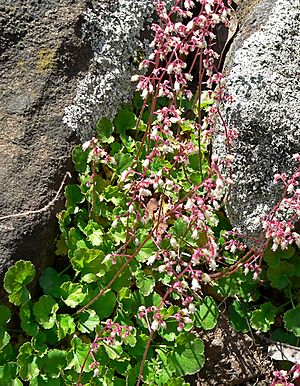Heuchera rubescens facts for kids
Quick facts for kids Heuchera rubescens |
|
|---|---|
 |
|
| Heuchera rubescens var. rydbergiana at the University of California Botanical Garden, Berkeley, California. | |
| Scientific classification | |
| Genus: |
Heuchera
|
| Species: |
rubescens
|
Heuchera rubescens, also known as pink alumroot, is a beautiful plant species belonging to the Heuchera genus. This small plant is a perennial, meaning it lives for more than two years. It is native to the Western United States and northern Mexico.
Contents
Discovering Pink Alumroot
The pink alumroot is a fascinating plant. It is known for its pretty flowers and interesting leaves. This plant is a great example of how nature adapts to different places. It thrives in specific environments, showing us the diversity of plant life.
What is a Perennial Plant?
A perennial plant is different from an annual or biennial plant. Annuals live for only one growing season. Biennials live for two seasons. Perennials, like the pink alumroot, live for many years. They often grow back from their roots each spring. This makes them strong and long-lasting.
Where Does Pink Alumroot Grow?
Pink alumroot is native to a wide area. This includes the Western United States and parts of northern Mexico. You can find it in states like California, Nevada, New Mexico, and Texas. It also grows in the Sierra Nevada (United States) mountains. This plant is found in places like the Mojave Desert and the Peninsular Ranges. It prefers rocky areas and canyons. It often grows in shady spots. This helps it stay cool and moist.
Habitat and Climate
The pink alumroot is very adaptable. It can grow in different types of soil. It prefers well-drained soil. This means water can pass through it easily. It also likes areas with some shade. This protects it from too much sun. The plant is often found at higher elevations. This means it grows in mountains or hills. These areas can have cooler temperatures. They also get more rain or snow.
What Does Pink Alumroot Look Like?
The pink alumroot is a relatively small plant. It usually grows in clumps. It has attractive leaves and delicate flowers.
Leaves of the Plant
The leaves of the pink alumroot are often rounded or heart-shaped. They usually grow in a cluster near the ground. This cluster is called a basal rosette. The leaves can be green. Sometimes they have a reddish or purplish tint. This color can be more noticeable in cooler weather. The edges of the leaves might be slightly lobed or toothed.
Flowers of the Plant
The flowers are a key feature of the pink alumroot. They grow on tall, slender stems. These stems rise above the leaves. The flowers are small and bell-shaped. They are often pink or reddish. This is how the plant gets its common name, "pink alumroot." The flowers bloom in spring or early summer. They attract small insects. These insects help the plant reproduce.
Life Cycle and Reproduction
Like all plants, the pink alumroot has a life cycle. It starts from a seed. Then it grows into a mature plant. This plant produces flowers and seeds.
How it Reproduces
The pink alumroot reproduces using its flowers. The flowers contain pollen. Insects like bees or butterflies visit the flowers. They carry pollen from one flower to another. This process is called pollination. After pollination, the flowers produce seeds. These seeds can then grow into new plants. The plant can also spread through its roots. This helps it form larger clumps over time.
Why is Pink Alumroot Important?
The pink alumroot plays a role in its natural environment. It is part of the local ecosystem.
Role in Nature
As a native plant, pink alumroot provides food and shelter. It can be a food source for some insects. It also helps prevent soil erosion. Its roots hold the soil in place. This is especially important in rocky or sloped areas. It adds beauty to the landscape. It is a part of the natural heritage of the Western United States.
Use in Gardens
Because of its beauty and hardiness, pink alumroot is sometimes grown in gardens. It is a popular choice for rock gardens. It also works well in shady areas. Gardeners like it for its attractive foliage and delicate flowers. It is a low-maintenance plant. This means it does not need a lot of care.

